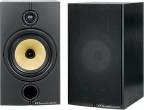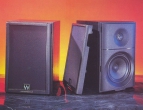Wharfedale Diamond 11.2 Bookshelf speakers
The first generation of Diamond appeared in 1981. Unexpectedly the great success of available monitors with advanced drivers for those years inspired the company to begin the development of Diamond II already a year later, which was more than once updated and upgraded. In 2001 the eighth generation goes on the conveyor, the ninth one - already in 2003, and the tenth - in 2008... And then another "diamond" wave in the form of models from the 100th and 200th series covered the consumer.
Such violent activity for 35 years within virtually one model concept speaks about that for Wharfedale the found solutions have become the engine for new (and sometimes very bold) research. We should look at Diamond 11 exactly in this context. In fact, these are newly developed loudspeakers, although continuity with predecessors is easy to follow. Look at, for example, the shape - the front wall is straight, and the side walls have a convex profile and taper to the back panel. Recent ancestors looked the same, but the proportions and radii are now chosen so that the internal volume stays large enough. They fight against resonances using the method proven on other models, making the hull elements of a multi-layered wood sandwich of different density.
In drivers Diamond 11.2 we see diffusers from Kevlar, which is familiar from very early projects. This material is used in Wharfedale for a long time and it is studied through and through. A basket with a clever grid of ribs provides the necessary rigidity. A Faraday ring is mounted in the magnetic mid-woofer system in order to reduce the back electromotive force. Large magnets are used to increase the overall sensitivity and the field parameters are so optimized that the driver stays linear at very high amplitudes as well as at low frequencies.
Tweeter with a textile dome also holds some know-how. The membrane on the reverse side works for a dead room and has a lowered frequency of self resonance. In the magnetic system there is a copper insert that controls the magnetic flux to minimize distortion.
Diamond 9.2 and 10.2, as we remember, allowed the bi-wiring connection. The engineers refused of this in the novelty, but invented for all models of the series (except for the central channels) a combined bass-reflex. Instead of a pair of ports, being placed forward or backward, a gap is spread across the entire width, which is rare in shelf loudspeakers. The company does not disclose details about the filters, but it is known that they are not calculated in the classical way, but are created first in several versions in a virtual environment, and then they are listened by experts on prototypes.
Installation of Diamond 11.2 with a large free space around them, as it turned out, is not the best choice. The overall musical balance is fairly accurate, but the tonal picture in each register is not devoid of specificity. Loudspeakers are slightly underpowered in the structure of high bass and at low mid frequencies, on the contrary, give an easy accent. An area of about 2 kHz is clearly distinguished in the middle, although the linearity of Diamond in the upper band, considering the price, should be recognized as an exemplary. As a result, the loudspeakers sound thoroughly, but a little piercingly. Although at the same time they are able to revive the sound of boring phonograms.
Wharfedale Diamond 11.2 has only one distinct feature. The characteristic signs of withdrawal may appear at high volume, when kick is very powerful or a bass guitar is with an energetic slap. This is the price for what Wharfedale engineers have been trying to do - to get 15-cm drivers to play low bass so believably and fundamentally that it would do proud to a floor speaker system. They really succeeded in this, but the area of the diffusers is physically not enough to create high sound pressure at deep bottoms. The "specialization" of Diamond 11.2 arises from this: they are not the best choice for fans of concert drive, but in their class do not have an alternative in terms of conveying the timbre richness of music at moderate levels.




